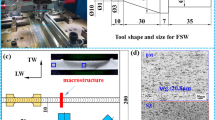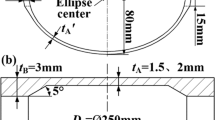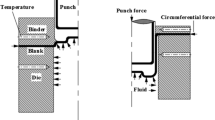Abstract
5A06 aluminum alloy has good corrosion resistance and no low temperature brittleness, so it is widely used in aerospace sheet metal components. However, when forming complex thin-walled parts, the surface forming quality and accuracy of the alloy are poor, and the forming performance is limited, which has been an important problem in application. In this paper, on the basis of hydrodynamic deep drawing, the rigid-flexible composite drawing warm forming process is innovatively proposed, which improves the forming quality of 5A06 complex bottom aluminum alloy parts and fittability. Taking aluminum alloy concave-bottom cylindrical parts as the research object, the influence law of rigid-flexible composite drawing warm forming process on the forming process and the fitting accuracy of concave-bottom cylindrical parts was explored by using the method of numerical simulation and forming experiment. The results show that under the process conditions of hydraulic pressure 20 MPa, sheet forming height 50 mm, and forming speed 1.8 mm/s, the maximum thinning rate of special-shaped bottom cylinder wall thickness is 21.3%, and the fittability is 97.3%.



























Similar content being viewed by others
Availability of data and materials
The data obtained in the framework of this study are available to the journal upon request.
References
Yang He, Luoxing LI, Wang Q, Lianggang G (2010) Research on the development of advanced forming for lightweight alloy materials area. Journal of Mechanical Engineering 46(12):31–42. https://doi.org/10.3901/JME.2010.12.031
Zhang S, Cheng M, Song H, Yong Xu (2020) Research progress on precision forming technology for complex curved surface components in aerospace. Journal of Nanjing University of Aeronautics & Astronautics 52(01):1–11. https://doi.org/10.16356/j.1005-2615.2020.01.001
Zhao S, Yuan J, Wang J (2006) Reverse drawing with liquid filling and numerical simulation of cylinder. Forging Equipment & Manuf Technol (02):440–48. https://doi.org/10.16316/j.issn.1672-0121.2006.02.015
Yang J (2016) Study on drawing law of box part with concave contour. Harbin Inst Technol (02):14–30. https://doi.org/10.7666/d.D756067
Naka T, Torikai G, Hino R, Yoshida F (2001) The effects of temperature and forming speed on the forming limit diagram for type 5083 aluminum–magnesium alloy sheet. J Mater Process Technol 113(1):648–653. https://doi.org/10.1016/S0924-0136(01)00650-1
Bolt PJ, Lamboo NA, Rozier PJ (2001) Feasibility of warm drawing of aluminium products. J Mater Process Technol 115(1):118–121. https://doi.org/10.1016/S0924-0136(01)00743-9
Vasco Simões; Hervé Laurent; Marta Oliveira; Luís Menezes (2019) The influence of warm forming in natural aging and springback of Al-Mg-Si alloys. IntJ Mater Form 12(1):57–68. https://doi.org/10.1007/s12289-018-1406-7
Takuda H, Mori K, Masuda I, Abe Y, Matsuo M (2002) Finite element simulation of warm deep drawing of aluminium alloy sheet when accounting for heat conduction. J Mater Process Technol 120(1):412–418. https://doi.org/10.1016/S0924-0136(01)01180-3
Cao XQ, Wang JW, Liu Y, Zhong CC, Li LC, Wang HX (2012) Research on the warm deep drawing of AZ31 magnesium alloy sheet based on DYNAFORM. Appl Mech Maters 138–139(1+2):754–758. https://doi.org/10.4028/WWW.SCIENTIFIC.NET/AMM.138-139.754
Liu XJ, Yao P, Li CY, Lin TX, Chao FZ, Wang YW (2016) Information of aluminum alloy cylindrical cups with concave bottom by pre-bulging hydrodynamic deep drawing special casting and non ferrous alloys 36(12):1333–1336.https://doi.org/10.15980/j.tzzz.2016.12.026
Abedrabbo N, Pourboghrat F, Carsley J (2007) Forming of AA5182-O and AA5754-O at elevated temperatures using coupled thermo-mechanical finite element models. Int J Plast 23(5):841–875. https://doi.org/10.1016/j.ijplas.2006.10.005
Wang H, Luo Y-B, Friedman P, Chen M-h, Gao L (2012) Warm forming behavior of high strength aluminum alloy AA7075. Transactions of Nonferrous Metals Society of China 22(1):1–7. https://doi.org/10.1016/S1003-6326(11)61131-X
Liu XJ, Gao JC, Li C, Ding HF (2020) Investigation on precision warm hydroforming with independent circumferential pressure of high-performance aluminum alloy parts with special-shaped bottom. Int J Adv Manuf Technol 109:201–213. https://doi.org/10.1007/s00170-020-05618-x
Ying L, Dai MH, Hu P (2015) Thermal constitutive model and numerical simulation of hot forming for 6061-T6 aluminum alloy. The Chin J Nonferrous Metals 25(7):1815–1821. https://doi.org/10.19476/j.ysxb.1004.0609.2015.07.010
Yongchao Xu, Li F, Liu X, Yuan S (2011) Effects of pre-bulging on 2024 aluminum alloy complex-shaped components. J Metals 63(5):39–41. https://doi.org/10.1007/s11837-011-0074-6
Li D, Ghosh A (2003) Tensile deformation behavior of aluminum alloys at warm forming temperatures. Maters Sci Eng A352(1). https://doi.org/10.1016/S0921-5093(02)00915-2
Funding
This paper was financially supported by Harbin academic leader fund (2017RAXXJ008) and National natural science foundation of China (51975167).
Author information
Authors and Affiliations
Contributions
Ying Ying Zhou: conceptualization, methodology, writing—original draft preparation, experimental scheme design. Xiao Jing Liu: writing—reviewing and editing. Li Chao: experiment. Jin Qin: verification, validation. Peng Chen: supervision.
Corresponding author
Ethics declarations
Ethics approval
Not applicable.
Consent to participate
Not applicable.
Consent for publication
Not applicable.
Disclaimer
This article is completed under my independent research, and without the phenomenon that quotes largely or plagiarizes other articles and so on. Therefore, I will be corresponding responsible for the thing.
Competing interests
The authors declare no competing interests.
Additional information
Publisher's Note
Springer Nature remains neutral with regard to jurisdictional claims in published maps and institutional affiliations.
Rights and permissions
Springer Nature or its licensor holds exclusive rights to this article under a publishing agreement with the author(s) or other rightsholder(s); author self-archiving of the accepted manuscript version of this article is solely governed by the terms of such publishing agreement and applicable law.
About this article
Cite this article
Liu, X.J., Zhou, Y.Y., Chen, P. et al. Study on warm forming process of rigid-flexible composite drawing based on numerical simulation. Int J Adv Manuf Technol 123, 839–853 (2022). https://doi.org/10.1007/s00170-022-10121-6
Received:
Accepted:
Published:
Issue Date:
DOI: https://doi.org/10.1007/s00170-022-10121-6




